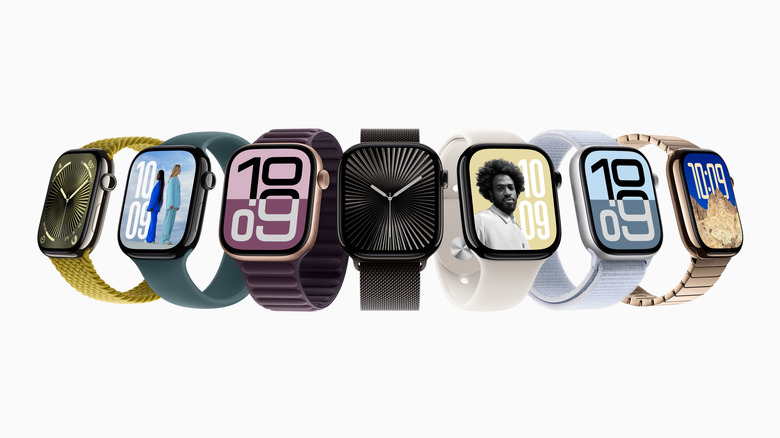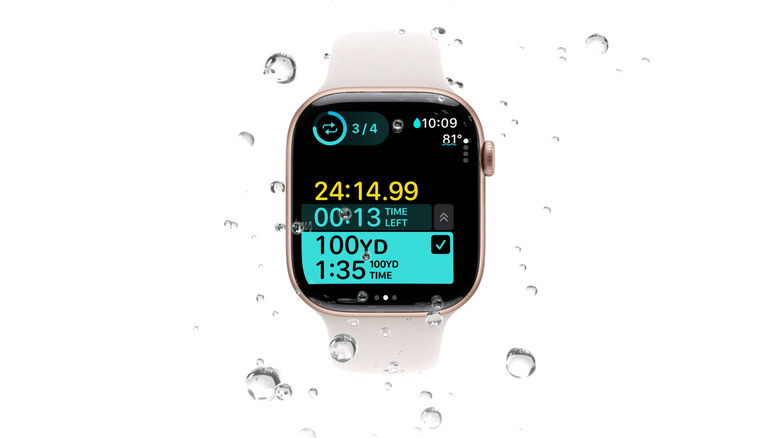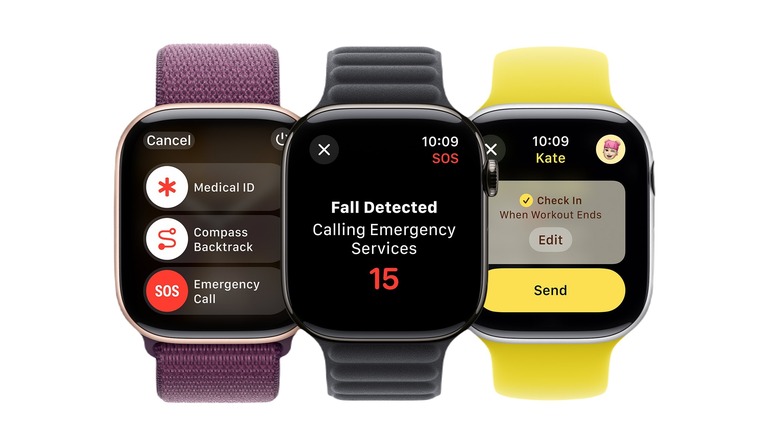Apple Watch Series 10 Vs Series 9: What's New And Is It Worth Upgrading?
Since its introduction nearly a decade ago, Apple's smartwatch lineup has gained in popularity and has been through several generations. On September 9, 2024, the company took the covers off its 10th-generation Apple Watch models. Called the Apple Watch Series 10, this updated lineup of smartwatches features several upgrades over their predecessors from the Apple Watch Series 9 lineup.
On the surface, the physical changes to the Apple Watch Series 9 seem hardly noticeable and may only be appreciated by folks with an eye for detail. Aside from subtle design updates, there are several changes to the internal hardware of the Apple Watch 10, some of which also let the lineup do some things that the Apple Watch 9 series could never handle. The most noticeable of these changes include the newer processor, a slightly larger display, and lower overall weight.
These changes, however, hardly scratch the surface, and if you are an existing Apple Watch Series 9 user thinking whether or not to upgrade to the Series 10 models, are the changes really significant enough to warrant an upgrade?
Bigger size, bigger display, but lower weight
While it might not become immediately apparent without a side-by-side comparison, Apple has confirmed that the Series 10 models are physically larger than their Series 9 brethren. Like with the Series 9 models, Apple offers the 10th generation watches in two sizes, except this time, the diameter of the case has gone up by a millimeter on both variants. So, the 45mm Series 9 model has been updated to 46mm on the Series 20. Similarly, the 41mm Series 9 models have been replaced by the 42mm Series 10 model.
While a millimeter might not sound like a lot, on something as small as the Apple Watch, it is still gaining some precious real estate. This slight increase in size has led to the Apple Watch Series 10 featuring a display up to nine percent larger than equivalent Series 9 models. This larger display lets the Series 10 models display an additional line of text on the display, which is invaluable as far as smartwatches go.
Not only is the display on the Apple Watch Series 10 larger, it also offers better readability thanks to the use of a wide-angle OLED display, with Apple claiming it's up to 40 percent brighter than the Series 9 when looked at from an angle. Apple has also upgraded the screen from a standard LTPO panel to an LTPO3 panel.
Despite featuring a larger display and cramming in more tech than ever before, Apple has kept the weight of the watches in check. In fact, all models of the Apple Watch Series 10 lineup are around 20% lighter than their Series 9 counterparts (for the Titanium case variant). Watches with an aluminum case are up to 10% lighter.
The new S10 chip and depth gauge
The Apple Watch Series 10 models also mark the debut of Apple's new watch-focused SiP (System in Package) called the Apple S10. It replaces the S9 SiP from last year's Series 9 models. Apple does not claim major performance gains with the S10 chip, but notes that in addition to a thinner profile, it was designed for "performance, power efficiency, and intelligence."
Apple's S10 SiP gets a four-core Neural Engine which powers several safety-focused Apple Watch features like Crash Detection and Fall Detection. For the Series 10 models, Apple has also developed an updated Smart Stack widgets feature, a redesigned Photos face, and a refreshed Translate app enabled by watchOS 11.
While the water resistance capability of the Apple Watch Series 20 lineup remains the same as before (50 meters), it gets two additional features the Series 9 models missed. These include an on-screen depth gauge (that works up to six meters) and a water temperature sensor.
Faster charging speeds, built-in speakers, and sleep apnea detection
Apple claims identical battery life on the Series 10 and Series 9 models (up to 18 hours in standard mode and up to 36 hours in low power mode). Where there is a noticeable improvement is the charging speed. Thanks to a larger, more efficient charging coil at the metal back of the Apple Watch Series 10, it can now charge from 0% to 80% in just about 30 minutes. On the Series 9 models, the same process took around 45 minutes.
Other new additions to the Apple Watch Series 10 include speakers that let users access content from apps like Apple Music, Apple Podcasts, and Apple Books, as well as several third-party apps without having to connect headphones. Apple also confirmed that the Series 10 models can double up as microphones for FaceTime calls and that the watch uses its Neural Engine to suppress background noise during calls.
The Apple Watch Series 10 can also detect a condition called sleep apnea. While the feature will make its debut on the Series 10 models, it will not remain exclusive to these newest-generation Apple Watches. The company's Series 9 models are also due for this update in the coming weeks.
Should Apple Watch Series 9 owners upgrade to the Apple Watch Series 10?
For most existing Apple Watch Series 9 owners, upgrading to the Series 10 only makes sense if you are in desperate need of the new features that are exclusive to the newer models. Unfortunately, the list of new features on the Series 10 isn't long enough for us to recommend an upgrade. While it does get a bigger display, a faster charging battery, and also sheds some weight, these additions aren't groundbreaking.
That being said, if you've been waiting for some specific features — like depth gauge, water temperature sensors, and the ability to use the watch speakers to consume content — to make it to an Apple Watch, and don't mind the additional cost of buying a new watch, upgrading to the new Series 10 models is a no-brainer, especially if you trade in your old Series 9 model.
The Apple Watch goes on sale in the U.S. starting September 20, 2024. Prices for the base variant of the Watch (42mm, GPS) start at $399. The 46mm GPS variant has been priced at $429. Prices for the 42mm GPS+Cellular options start at $499, and the 46mm GPS+Cellular variant will set you back by $529.




